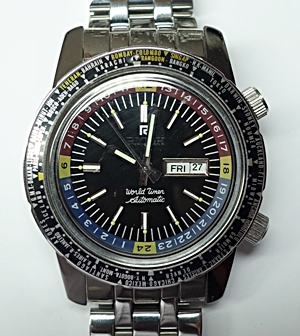
Before we start with the watch movements, let’s have a little excursion into the history of Ricoh: it begins in 1936 with the founding of Riken Kankoshi Co. Ltd. As early as 1938 it became the Riken Optical Co. Ltd., which manufactured optical devices, including cameras. In 1963, it became Ricoh Co. Ltd., which is still active as a multinational corporation.
The origins of the watch division of Ricoh, however, come from another Japanese company, the Takano Seimitsu Kogyo Co., which was founded in 1938.
![]()
About Takano and their movements, I have already reported here in detail: Takano, the Phantom Japanese Watch Manufacturer
On May 8, 1962, the president of Riken Optical Co. Ltd. took office as president of Takano. In August 1962, Takano Seimitsu Kogyo Co. became Ricoh Tokei Co. Ltd., which, being renamed again to Ricoh Elemex Corporation in 1986, still exists today.
Now, this is about the automatic watch movements of Ricoh. A short time ago, I still thought that there are only two variants, the Ricoh 61 for men’s watches and the 251 for ladies’ watches.
The reality, however, is much more complex. There were not only different types of these two movements, which also have different caliber numbers, but also quite different families of movements.
The decisive clues to the Ricoh watch movement families and their variants were provided by the 2019 published book 森年樹: 国産腕時計タカノ・リコー (Domestic Watches: Takano・Ricoh), トンボ出版 (Dragonfly Publishing), Year: 2019, ISBN 9784887161191. Unfortunately, this book is only available in Japanese!
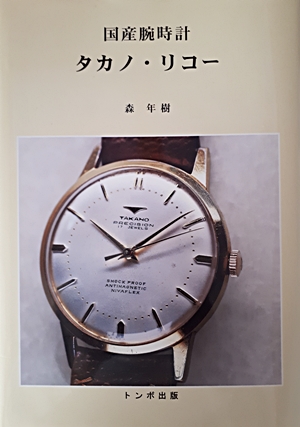
Here we will focus on the automatic movements of Ricoh, so let the hand-wound ones aside. I was able to identify the following automatic movement families from Ricoh:
The Ricoh 54 Series
The first automatic movements from Ricoh use the Takano caliber 544, which was supplemented in 1962 with an automatic module. The family includes three variants, which have the following features in common:
- Size: 12 3/4´´´ (French lignes, 1 ligne = 2.26 mm)
- Beat rate: 18.000 bph (beats per hour)
- Hour, minute, sweep second
- Rotor with ball bearings
| Caliber | Year | Jewels | Date | Day | Shock protection | Remarks |
| 54610 | 1963 | 33 | – | – | KIF 210 Trior | Ball bearing rotor with metal balls |
| 54710 | 1962 | 33 | X | – | KIF 210 Trior | Ball bearing rotor with metal balls |
| 54722 | 1962 | 45 | X | – | KIF Flector | Ball bearing rotor with ruby balls |
Here we have a 54710 in a Ricoh Dynamic Auto:


These movements are, to my knowledge, not labeled with the caliber number, but they can easily be compared to other Ricoh movements by the shape of the balance cock, the position of the balance in relation to the winding stem, the functions (day yes/no) and the number of jewels ( 33/45).
The Ricoh 1200 series
This family of works does not seem to have a Takano base, so it was probably created under the aegis of Ricoh. This family also includes three variants which have the following features in common:
- Size: 11 1/2´´´ (French lignes)
- Beat rate: 18.000 bph (beats per hour)
- Hour, minute, sweep second
- Rotor without ball bearings
| Caliber | Year | Jewels | Date | Day | Shock protection |
| 1216 | 1963 | 21 | – | – | KIF 210 Trior |
| 1217 | 1963 | 21 | X | – | KIF 210 Trior |
| 1218 | 1964 | 21 | X | X | KIF 210 Trior, Monorex |
Here a caliber 1218 in a Ricoh Auto Deluxe:


These movements are easily recognized by the balance bridge (two attachment points) instead of a balance cock (a point of attachment). Together with the functions (date/day), these calibers can be distinguished, since these movements are not marked with the caliber number.
The Ricoh 2000 series
Again, a new family of movements, of which there are (originally) only two versions that have the following features in common:
- Size: 12 3/4´´´ (French lignes)
- Beat rate: 18.000 bph (beats per hour)
- Hour, minute, sweep second
- Rotor without ball bearings, but with a ruby bearing
However, a reader of this article sent me pictures of a Ricoh movement that clearly belongs to the 2000 family and has a date display and a 24-hour display! Unfortunately, the caliber designation is not known.
| Caliber | Year | Jewels | Date | Day | 24h | Shock protection |
| 2337 | 1964 | 33 | X | – | – | KIF 210 Trior |
| 2338 | 1964 | 33 | X | X | – | KIF 210 Trior |
| ? | ? | 33 | X | – | X | KIF 210 Trior |
These movements were used in watches named Ricoh Punch and Ricoh Auto Just. They seem to be quite rare though.

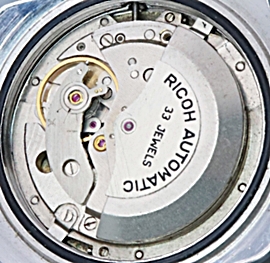

Based on the rounded shape of the balance cock and the function (date / day), these movements are very easy to identify.
The Ricoh 30 series
THE automatic family of Ricoh, as movements from this family are most often found in Ricoh watches. Unfortunately, this family has many members, which are visually hardly distinguishable from each other.
But let’s first look at the similarities of these movements:
- Size: 12 3/4´´´ (French lignes)
- Beat rate: 18.000 bph (beats per hour)
- Hour, minute, sweep second
- Rotor with ball bearings
| Caliber | Year | Jewels | Date | Date fast correction |
Day | Day fast correction |
Shock protection | Remarks |
| 30 | 1966 | 21, 25 |
X | Pull crown |
Outer or inner ring |
– | Monorex | Massive rotor without slit, Ball bearings with metal balls |
| 31 | 1966 | 21, 25, 28, 30 | X | Pull crown | Outer or inner ring | – | Monorex | Massive rotor without slit, Ball bearings with metal balls |
| 32 |
1966 | 21 |
X |
Repeatedly changing 20 – 24h |
Inner ring, but day name spelled out | – |
Monorex | Massive rotor without slit, Ball bearings with metal balls |
| 33 |
1967 |
35 |
X |
Push button |
Outer ring |
X |
Monorex |
Rotor with slit and heavy metal rim, ball bearings with ruby balls |
| 34 | 1966 |
30 |
X |
Push button |
Outer ring | – |
Monorex | Massive rotor without slit, Ball bearings with ruby balls |
| 36 |
? |
17 | X |
Pull crown | Outer ring | – |
Monorex | Massive rotor without slit, Ball bearings with metal balls |
| 38 |
? |
17 |
X |
Pull crown | Outer ring | – |
Monorex | Massive rotor without slit, Ball bearings with metal balls |
| 39 | 1966 |
21, 30 |
X |
Pull crown | Inner ring, but day name spelled out | – |
Monorex | Massive rotor without slit, Ball bearings with metal balls |
| 40 |
1970? |
21 |
X |
Pull crown | Outer ring | – |
Monorex New | Rotor with slit and heavy metal rim, Ball bearings with metal balls |
| 41 |
1970? |
21 |
X |
Pull crown | Inner ring | – |
Monorex New | Rotor with slit and heavy metal rim, Ball bearings with metal balls |
| 42 |
1968 | 26 |
X | Push button |
Outer ring | X |
Monorex | Rotor with slit and heavy metal rim, ball bearings with ruby or metal balls |
| 44 |
1966 |
21 |
X |
? | – |
– |
Monorex | Massive rotor without slit, Ball bearings with metal balls |
| 48 |
? |
21 |
X |
Repeatedly change 21 – 24h | – |
– |
Monorex | Massive rotor without slit, Ball bearings with metal balls |
| 49 |
1968 |
30 |
X |
Pull crown | Outer or inner ring | – |
Monorex | Massive rotor without slit, Ball bearings with metal balls |
| 50 |
? |
30 |
X |
Pull crown | X | – |
Monorex | Massive rotor without slit, Ball bearings with metal balls |
| 61 | 1970 |
21 |
X |
Push button |
Outer or inner ring | – |
Monorex New |
Rotor with slit and heavy metal rim, ball bearings with metal balls |
| 63 |
? |
25 |
X |
Pull crown | X | – |
Monorex | Massive rotor without slit, Ball bearings with metal balls |
| 65 |
? |
25 |
X |
Pull crown | X | – |
Monorex | Massive rotor without slit, Ball bearings with metal balls |
| 66 |
? |
28 |
X |
Pull crown | Inner ring |
– |
Monorex | Massive rotor without slit, Ball bearings with metal balls |
| 67 |
1970? |
30 |
X |
Push button |
Inner ring | – |
Monorex | Rotor with slit and heavy metal rim, ball bearings with ruby balls |
| 68 |
1970 |
35 |
X |
Push button |
X |
X |
Monorex | Rotor with slit and heavy metal rim, ball bearings with ruby balls |
| 71 |
? |
30 |
X |
Pull crown | Inner ring | – |
Monorex | Massive rotor without slit, Ball bearings with metal balls |
| 72 |
1969 |
28 |
X |
Pull crown | X |
– |
Monorex | Massive rotor without slit, Ball bearings with metal balls |
| 74 | 1969 |
26 |
X |
Push button |
X |
X |
Monorex | Rotor with slit and heavy metal rim, ball bearings with metal balls |
| 75 | ? |
21 |
X |
Push button |
Inner ring | – |
Monorex New |
Rotor with slit and heavy metal rim, ball bearings with metal balls, day/date always at 6H instead of 3H? |
| 80 | ? | 26 | X | Push button | Inner ring | – | Monorex | Massive rotor without slit, Ball bearings with metal ballsMovement with stop seconds |
| 84 | 1969 |
21 |
X |
Pull crown | X |
– |
Monorex | Rotor with slit and heavy metal rim, ball bearings with metal balls |
| 86 | 1970+? | 30 | X | Pull crown | Inner ring | – | Monorex New | Rotor with slit and heavy metal rim, ball bearings with metal balls |
Initially, all the movements of the 30 series were equipped with a Monorex shock protection. Around 1970, this was replaced by the Monorex New.

Here are the two different variants of the rotor:

Unfortunately, the unambiguous identification of these many variants is not always easy, since the movements are never labeled with the caliber number. The assignment with the table above is not always unique, so there are probably more details to consider, that I could not identify yet. Such a further feature could be the winding wheels of the automatic module, which (presumably) have holes in older movements, but none in newer variants:

The good news is that the movements can very often be identified by the reference number on the caseback of the watch. This usually begins with the caliber number, occasionally it has a leading zero, so e. g. 61xxx or 061xxx:

The caliber 61 is by far the most common variant of this family. It can be found in the Ricoh World Timer shown at the very top and in this watch which dates around 1970:

In the picture above you can see a push button at 2 o’clock, which serves to quickly adjust the date. For the day display, there is no quickset mechanism, so here the hands must be rotated clockwise until the correct day is displayed.

In the 1970s, Ricoh movements were also used in watches of the brand RonTic of the German silverware manufacturer Robbe & Berking. They were equipped with the caliber 67. I suspect that Ricoh produced the whole watch and did not only provide the movement.
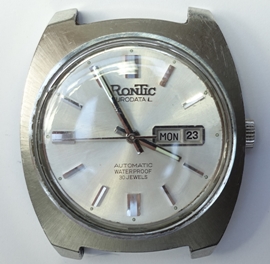
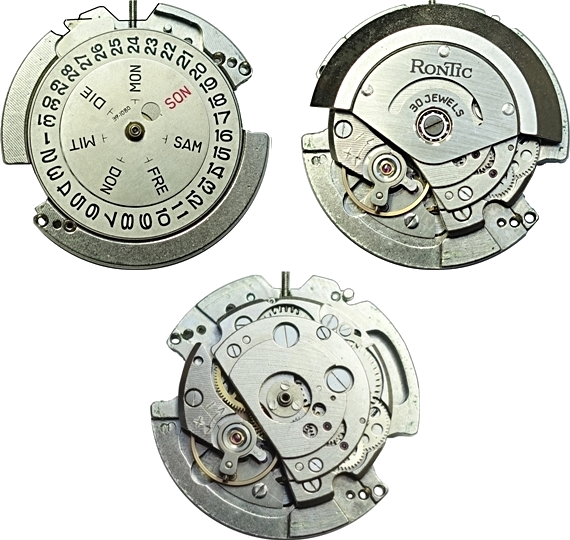
This watch also has a push button at 2 o’clock for quick adjustment of the date. Here the button lies so deep that he is not visible in the picture.
The Ricoh 67 has 30 jewels, of which nine are used as ball bearings of the rotor.
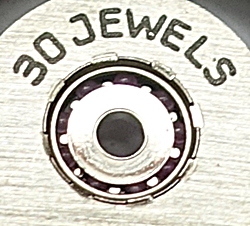
And another German manufacturer, Dugena, has used Ricoh movements as well:
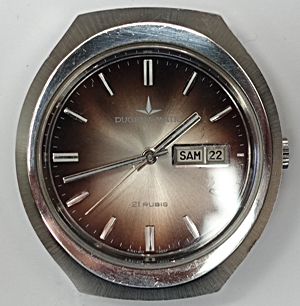
The Dugena 5400 is a Ricoh 41. The bottom of the dial of this watch is labeled with R41.
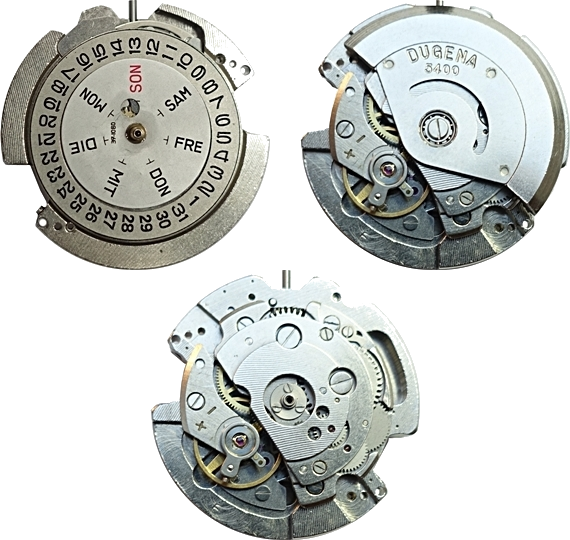
In this movement, the quickset of the date is done by repeatedly pulling the crown, thus the caliber 41 does not need an extra push button for that.
Here you can see the difference between the two variants of the quickset mechanisms. The red arrow marks the position where the pusher attaches:

And finally a Ricoh 48, which only has a date display but no day display. This movement does not have a date quickset, but the date can be adjusted semi-quickly by repeatedly turning the hands back to 9 p.m. and then turning them forward to midnight.

By the way, there are also at least two members of the 30 series family with manual instead of automatic winding: the Ricoh 53 with date and day and the Ricoh 55 with date display only.
Now we have dealt with the automatic movements for men’s watches. But there are also two families of movements for ladies’ watches:
The Ricoh series 25
Movements for ladies’ watches that have the following features in common:
- Size: 7 3/4´´´ (French lignes)
- Beat rate: 21.600 bph (beats per hour)
- Hour, minute, sweep second
- Rotor without ball bearings
| Caliber | Year | Jewels | Date | Day | Shock protection | Remarks |
| 251 | ~1975 | 21, 22 | X | – | Monorex New | |
| 259 | ~1975 | 17 | X | – | Monorex New |
Except for the number of jewels, these variants are technically identical. Without automatic module, the same movement base does also exist as manual winding calibers: the caliber 252 with date and the 253 without date.
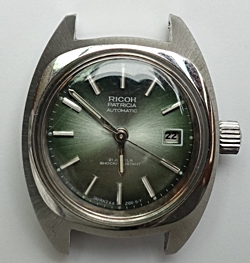


At least the movement with 22 jewels is also available with a different rotor shape:

The caliber number is not found anywhere on these movements, but as the beginning of the reference number on the caseback of the movement. In contrast to Ricoh’s series 30 family, the few variants of the series 25 can be easily distinguished.
The Ricoh series 29
Movements for ladies’ watches that were not developed by Ricoh but sourced from third-party manufacturers. Interestingly, Ricoh also used movements from Switzerland. It is striking that these ladies’ watches have both a date and day display. Ricoh did not have a self-developed ladies’ watch movement with both displays.
| Caliber | Size | Year | Jewels | Date | Day | A/h | Remarks |
| 293 | 8´´´ | ~1975? | 17 | X | X | 28.800 | = Seiko 2906A (Japan) |
| 294 | 8 3/4´´´ | ~1979? | 17 | X | X | 21.600 | = AS 530.622 (Switzerland) |
There may be more 29x movements belonging to this family.


Wie bei den Serien 30 und 25 findet sich auch hier die Ricoh-Kalibernummer meist nur als Beginn der Referenznummer auf dem Bodendeckel der Uhr:
As with the series 30 and 25, the Ricoh caliber number is usually only found as the beginning of the reference number on the caseback of the watch:

Back to the starting point of this article, which started with the assumption that there are only two different automatic movements from Ricoh, the caliber 61 for men’s watches and the 251 for ladies’ watches. Now we have identified six movement families with a total of 38 variants. Admittedly, the variants of the 30 series family, to which the caliber 61 belongs, often differ only in trifles.
But I suspect that there are more variants of the Ricoh movements in the 30 and 29 series!

thanks for this great article, by the way out of all ricoh movements mentioned here, Can u tell which is the best movement of ricoh by far.
Sorry, I can’t tell you which ist the ‘best’ Ricoh movement.
Thanks for this very useful information about Ricoh movements. I got several of them, and like them very much. I am most proud of my Ricoh 54722, with the rotor still original. Also got some Takano watches, so Takano/Ricoh is on my mind…
bonjour, j’ai 2 montres ricoh diver automatiques boitier 087319AA, inscriptions cadran 342 311-5.
avez vous des infos sur ce modèle , car il y a une bague tournante intérieure qui est actionnée par un pignon fixé sur la tige de remontoir , or le pignon ne passe pas dans le tube de boitier (tube et couronne à visser ) je ne comprends pas comment on démonte pour sortir cette tige ?
merci .
Sorry, I can’t help you with specific Ricoh watch models.
Hi,
Fantastic work, nothing else like it to be found. I’ve just serviced a Richo DX and I’m going to put a video on YouTube about it. Could I reference your site and include some screenshot please? Here’s my channle
https://www.youtube.com/channel/UCSQIRFSoGuw5k2xYF3EpUdw
All the best
Alec
Hi Alec,
feel free to use some material from my site, but please quote the source.
Thanks Andreas, of course. I’ll drop a link when it’s done.
Finally got it done….so many edits…thanks for the info, pretty sure the watch is a 61 movement in a 34 case. Had a lot of fun working on it though.
https://youtu.be/r7_zLAq3MYQ?si=NvY5c41cxp1GeyYJ
Wow it was really informative article about Ricoh watches.
Fortunately I have 4 Ricoh watches 1 winding and others are automatic.
Those are passed on from my father to me. I was always curious about their age. Can you please tell us that when did Ricoh stopped manufacturing watches?
Unfortunately I don’t know when Ricoh stopped producing watches. But they were still in business in the 2010s with solar watches.
In 1981, I received a RICOH 061447 watch as a gift from my father. It was bought in Libya. I haven’t found any information about this model anywhere. Maybe someone has the same one or will send information about it. Thank you in advance.
This is extremely helpful, thank you for this deep dive.
I am unsure as to which era my watch is from. I do know it is a day date series 61 as the serial number on the backplate starts with a 061. However, I am hoping you can help pinpoint the year and make of mine.
1. It has a brownish-black face.
2. Radium hour and minute hand
3. Silver bezel
4. The name brand RICOH is missing on the face, but is both on the rotor and the backplate.
5. It has the number 9 beneath which, in order, appear the following sentences. 21 Jewels > Automatic
6. Golden bars for time instead of numericals.
7. Date push button at 2 o’clock, key at 3 o’clock
Sorry, I can’t help in this case.
do you know how to decode Ricoh caseback code? mine is 061698AC year?
In my opinion there is nothing to decode, except for the movement code 61. The rest is most likely a reference number for the case.
Thank you for this fantastic overview of automatic watches from an iconic brand. I still use my grandfather’s Ricoh, and it still keeps ticking without a beat. Sadly this level of workmanship won’t be seen again in budget segment timewear, Especially with the advent of cheap smart watches.
Just like to ask, whether Ricoh had their initial on the crowns from the very beginning?
Thanks
I have no idea, sorry.
I bought a Ricoh R31 watch on ebay and the screw back shows the inscription “Ricoh Watch India” with the serial number “061884” the movement seems original but how can I be sure?
Honestly the watch looks beautiful, the case is steel and has a flat glass, it is not plexiglass. I would appreciate your comments, thank you very much.
I can’t tell you anything about your specific watch. According to the number on the back, the movement should be a Ricoh 61.
As always: you buy the seller! If you bought the watch from India, it is very likely to be a Franken watch. Movements and cases are most times original, but assembled from different watches. And dials are nearly always re-painted.
My old Ricoh is battery operated. RIQUARTZ
AGP
Japan 632004.
Must be very old, but still keeps time.
Great research and most welcome to see! I have a few Ricohs, including an “India”. Your article has been a great resource for me. Thank you very much.
Very good and interesting article! I just got myself a Ricoh Wide automatic (not Dynamic Wide). The caseback has W-letter surrounded by laurel leaves. It has 21 jewels, push button for day change and massive rotor without slit and with steel ball bearings. I don’t find exact match but it could be a #44 movement. Nice watch with very fascinating dial also.
Thank you, just got a 061449 – very nice watch
The problem is to find spare parts…
Amazing report. Ricoh is the fourth, always forgotten, big japanese brand and is really hard to find information in the net. Thank you for sharing that. Today you can find hundreds of Ricohs in the bay all of them sourced from India. Do you know if Ricoh keeps some production facility there or are them local copies?
As far as I know Ricoh does not keep any production facility for mechanical watches in India. There are some older Ricoh watches that are marked as made in India, but most of the Ricohs you can find in the bay from India are Franken watches. The dials are refurbished, and most of the movements are in very poor condition. Unfortunately the same is true for some sellers in Spain and the UK.
Thanks. Thinking of purchasing a Ricoh World Timer from an on-line source. Wondering if these movements can be serviced today. Thanks!
Sure, they can be serviced by any (real) watchmaker. Getting spare parts might be a bit tricky, as for most vintage watches. But spare parts should only be necessary, if something is broken.
Hello Andreas. Do you know where I can find information on a 1970s Ricoh Atlas (083301 AA)? Thanks.
Unfortunately no.
Fascinating read about an undervalued / underacknowledged brand. Thank you!